Q&A How to Become a Grill Master Using Stellar Grilling Tips & Guide
The grilling process involves applying dry radiant heat to the surface of food. The heat is generally applied from above the meat, such as when meat is cooked beneath the grill. But, heat can also be applied beneath the meat on a barbecue, hot plate or griller pan. The heat can also be applied from the side, or from all sides at once. Grilling, as distinct from roasting or baking, involves applying a large intense amount of radiant heat directly to the food surfaces. Grilling is used to cook meat and vegetables quickly, with the outside surfaces cooked quicker amd more intently than the inside of the food item. Food can be grilled over a fire or flame sources on a wire grid, barbecue grill or hot plate. Food can also be grilled on gridiron using a cast iron plate or ribbed frying pan.
With grilling over a flame or other heat source, the heat is mostly applied to the food via radiation of heat from the source. Heat transfer using a griddle or grill pan is by direct conduction of heat. In the United States and some other countries, grilling from a radiant source above the food in part of the oven is referred to as 'broiling'. The pan containing the food when broiling is referred to as a 'broiler pan', and heat transfer is via thermal radiation.
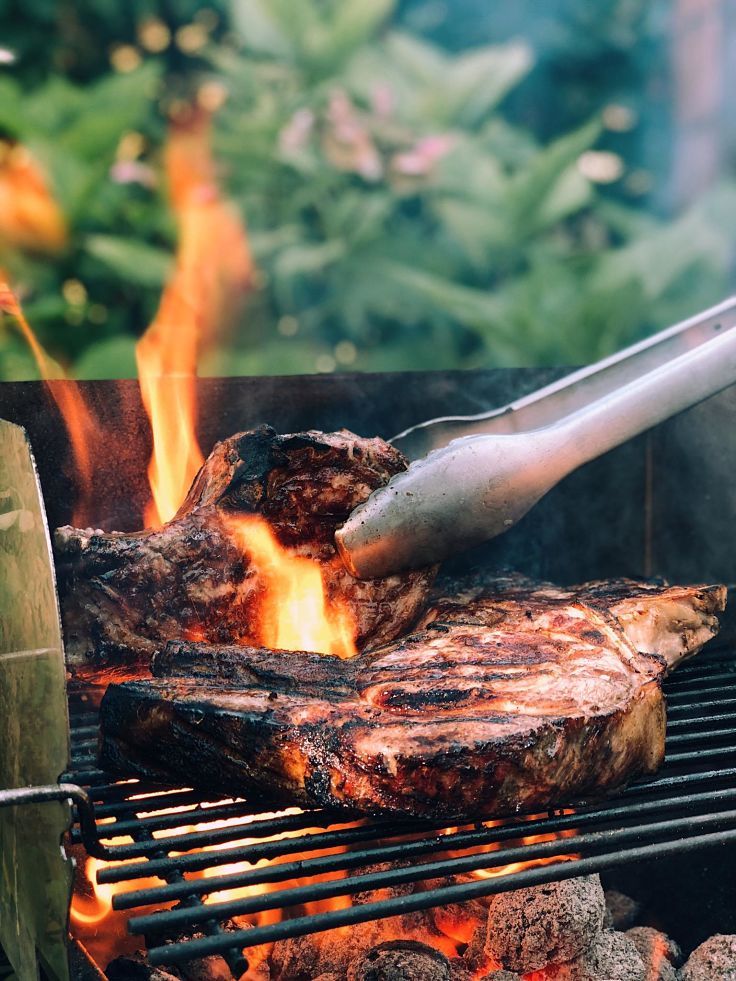
The direct searing heat applied to food items during grilling can expose food to temperatures over 260 degrees C (500 degrees F). Grilled meat and vegetables acquire distinctive flavors and aromas from a chemical process referred to as the Maillard reaction. The high temperatures induce a chemical reaction between the reducing sugars and amino acids in the foods that imparts the browned color and distinctive flavor to grilled foods.
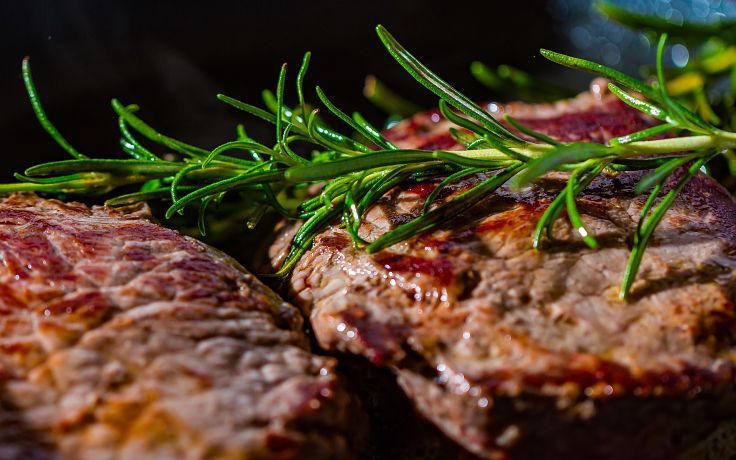
Becoming a Grill Master involves learning the secrets of the grilling process and avoiding the pitfalls! We asked a group of top chefs, butchers, barbecue experts and other professional people to provide you with the best grilling tips and guides to make you a grill master star. See the grilling tips below to boost your grilling skills and performance.
Ditch the Marinading Step, Use Super Hot Grill, Season Well When Cooked
Thoroughly dry the food to be grilled. Get the clean grill super hot on one side, with a cooler zone on the other. This allows you to pause some items which are just about done, while you bring the others up to speed. Grill the food items fast over direct heat until the fire-facing surfaces release naturally from the grate. Then, flip over and cook the other side until the outsides are golden, lined with char streaks. Check the inside of thicker pieces are just cooked through. Move cooked items to the 'cool zones' while you finish cooking the other items. Then season immediately you remove the items from the heat. Season liberally with fresh or spicy seasonings that are acidic, salty, but will not burn or smoke when in contact with the hot food. This method ensures the items are tender and tasty with maximum caralemization. Cooking quickly keeps the juices inside the food items.
Add the Oil to the Meat and Vegetables Rather that Oiling the Grill or Hot Plate Surface
This reduces the amount of smoke and puts the oil just where you want it - on the meat.
Stop Playing with Your Meat and Flipping Too Soon and Too Often
Stop playing, prodding and flipping with your meat. If you poke, prod and press your burgers and other meat and vegetable items you risk spoiling it. This causes those delicious and precious juices to be lost below. For the juiciest burgers meat and fish ever try cooking on the fat or skin side for about 70% of the total time. Only flip them once when you can see the layer of cooked protein rise to half way or beyond on the heat source side. Another point is that if you try to flip a burger or a steak too soon, it will tend to stick to the grates or hot surface. Cook your food well on the first side before turning!
Tips for Grilling with Skewers
Soak wooden skewers in water for 20 minutes before use. They will then not burn when food is grilled. It is unwise to put both meat and vegetables on the same skewer. Inevitably some items will not be cooked and others will be overcooked. Only skewer vegetables together when they will cook in the same time period. Skewer the meat and vegetables vegetables separately. The food items must be suitable as most items will be well cooked on the outside and raw on the inside. Do not pack the items too tightly together on the skewer as this prevents even cooking. Metal skewres will never burn like the wooden ones. Use twin skewers or flat shaped ones to stop meat and other items spinning on the skewer.
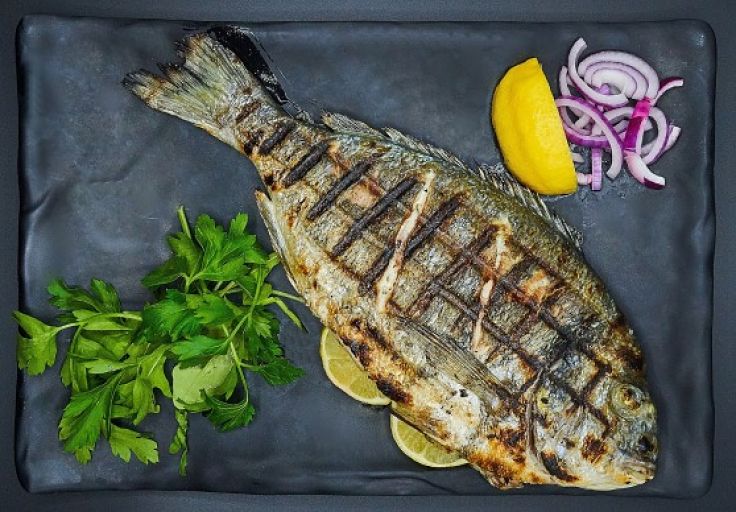
Keep Ice Water or a Water Sprayer on Hand to Stop Grill Flare-Ups
If flames flare up when the melted fat drips on the fire or grill, spray with water or add some ice cubes to calm it down.
Make Vegetable Rafts to Prevent Asparagus Spears and Spring Onions Falling Through
Long slender items, such as asparagus and spring onions, can be hard to handle on the grill. To stop them falling through and make them easy to handle make “rafts” out of the spears by threading very thin wooden skewers through the spears to bond them together. This can be used for spring onions and other vegetables.
Use Foil Sparingly and Wisely for Juicy Grilled Chicken
It is better to grill marinated chicken pieces or delicate foods such as fish over slowly over low heat for up to 45 minutes. Keeping covered with aluminium foil means that they cook slower than other items on the same grill. Open the foil packets towards the end of the cooking time and cover the grill with the lid. This ensures the chicken is juicy yet you still get a nice grilled char taste.
Finish Roasted Food on the Grill for the Perfect Char Taste
Finish meats that you’ve cooked in the oven in a pan on the grill. This creates a charred or crusted outer coating for the meat while ensuring the meat inside is medium-rare, the way you like it.
Use Mayo instead of a Marinade for Extra Flavor
Brushing on a very thin coating of mayonnaise on meat and chicken just before grilling helps it caramelize better. Better still, season the mayo with citrus zest, herbs, spices and other flavors.
Get and Use the Right Tools
Grilling like a master means having the right tools at hand to do the job better, simpler, faster, and with less stress and drama. Use good quality tongs to turn your meat or vegetables over on the grill. Tongs are very gentle on the meat and their use avoids having to poke holes in it using a fork. A perforated grill pan or plate is ideal for cooking fish and vegetables. A griddle plate is also a great tool for cooking steaks, lamb chops, pancakes, eggs, bacon etc., on your stove top. A rotisserie package provides many options for cooking large pieces of meat. Adding BBQ accessories such as wind guards to outdoor barbecues helps prevent heat loss and maintaining the proper temperature.
Use the Right Recipe
It's a mistake to assume that you don't need a recipe for grilling and barbecuing. A good recipe makes it better! A great recipe makes it spectacular!
Presentation Matters a lot with Grilling
Master grill masters know that presentation is just as important as flavour. Lets face it brown, dark grilled food can be very unattractive except to cavemen! Getting the grill marks right is an art form you should master. Adorn your grilled food with lots of color using vegetables, fruit and even flowers to make it a work of art for the beholder! Blackened food may taste good, but is can look bad!
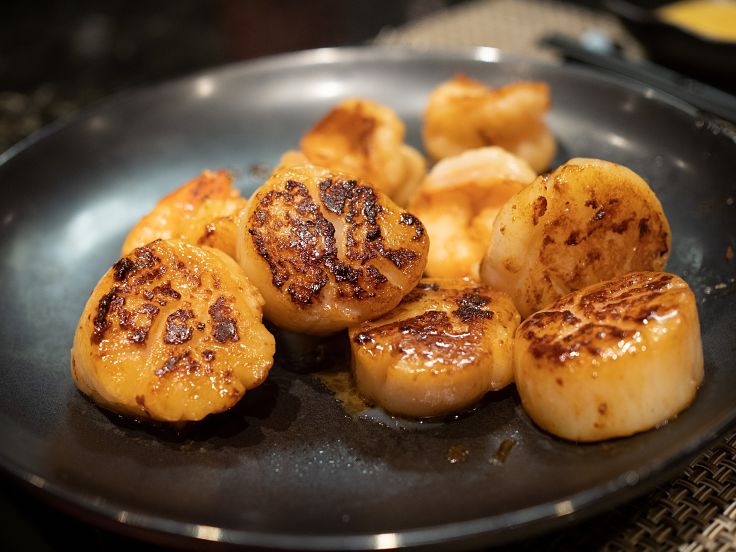
Make Wise Use of Salt and Let your Meat rest BEFORE Grilling
Improve the way lesser cuts of meat cook and taste by sprinkling it generously with salt about an hour before you grill it, whilst you wait for it to come to room temperature. Salt does not “bleed” the juices from raw and uncooked meat. Far from it. Salt helps steaks develop a delightful savoury crust as they cook, sealing the juices in. Just before placing your steaks on the grill or griddle, sprinkle on a generous amount of coarse salt, Don't add freshly ground black pepper at this stage as it could burn. Always wipe excess marinade off meat items before you grill them, and add salt. Many of the ingredients in the marinade may burn when grilled, ruining the taste.
Let your steak rest out of the fridge for at least 15-30 minutes before grilling to allow it to get to room temperature. If you place a cold steak on the grill, it won't cook well and may well be under-cooked internally. It will also dry out much more easily.
Always Rest Larger Pieces of Meat AFTER Cooking
When meat is grilled all the muscle fibers inside the meat contract. This drives the juices into the center of the cut. If you serve meat straight after taking off the grill, the juices can quickly leach out, leaving the meat dry and tough. Letting the meat rest for 5-15 minutes after it comes off the grill will allow the meat to reabsorb and redistribute the juices. This means that the meat will be more juicy and tender, with better flavour. Large pieces of meat especially need to be rested after cooking. A large piece of beef, a leg of lamb or a pork shoulder, need to be rested for a lot longer than is needed for a steak, perhaps for 15-25 minutes depending on the thickness. Use a meat thermometer to ensure the meat inside is cooked properly - just the way you like it.
Use Rubs and Marinades to Enhance Flavor
Bold sauces and rubs increase the flavour of bland pieces of meat. Scoring the outer surface and fat layer, allows the rub or marinade to penetrate. But, you don’t have to marinade everything, especially fish, seafood and very high quality cuts of meat. Adding a glaze at the end of the cooking process (within the last 10 minutes) is a great way to enhance the flavor! Dipping the pieces in a very dilute bowl of the marinade mixture works well. Aim for the consistency of soy sauce. Dunk your meat in it, just before you start cooking it on the grill.
Keep Your Grill Clean
You need to clean your grill grates, griddles and hot plates sparkling clean - every time, and sometimes during a cooking session clean. Nothing ruins a good grill quicker and completely than having the taint and black remnants from a dirty surface all over it. Coffee is acidic so works great for cleaning grills. There are many other ways to do it.
Use both Direct and Indirect Heat to Create Zones on your Grill or BBQ
When working multiple items with a grill that has a large surface area it pays to establishing different heat zones. Keep one section at a lower temperature another at medium and a final one very hot, directly above the flames. Establish areas with direct and indirect heat. As your meat and vegetable items start to become cooked move them to a cooler zone to slow down the cooking.
Know When to Keep the Lid On or Off
This depends on what you are grilling. Every time you open the lid you will lose heat and the temperature will drop. So the lid can be part of the temperature control. Thin, quick-cooking cuts of meat can be cooked with the lid off. Thick cuts of meat will cook better with the lid on. You can use the grill as an oven with the lid on.
When to Add Sauce and When to Add Salt
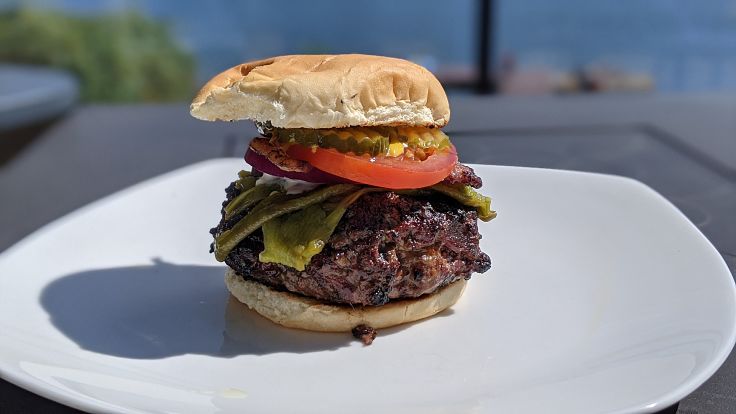
Grilled food often benefits from a final glaze or brushing with sauce or marinade to boost the flavor of the dish. But, do not add the sauce as soon as you put the meat on the grill. It is better to wait and add salt first. Adding sauce too early may cause the outside to char too early or to burn before the meat is cooked. Brush or drizzle some sauce over the meat towards the end of the cooking time and save the rest for serving.
Do not Pack Burger too Tightly and Leave a Crater in the Top
Loosely packed burger patties retain their juices better and cook better while grilling. Also, burgers can pop up in the center as they cook, making the tops rounded like mini 'mountains'. This makes adding the filling awkward. To avoid this, press an indentation or a 'crater' into the top of each patty with the back of a spoon or your thumb. The shape is also not really important so don't worry about perfect circles.
Preheat Your Grill
Similar to ovens, grills need to be pre-heated before you start cooking. The coals in a char-grill also need to be at the right temperature for ideal grilling. Lower your lid to hasten the pre-heating process. With all the gas burners set to high or the coals glowing red, hot, aim for a temperature under the lid of about 500 degrees F (260 degrees C) before you start cooking. Getting you grill hot also helps stop food items from sticking to the grate. Your grate needs to get hot enough to sear properly.
Keep the Lid Down When Cooking
This is better because it:
- stops flare-ups by limiting oxygen.
- keeps the grates hot so it sears the food.
- speeds up the cooking process and lessens the tendency for the food to dry out.
- It traps in the smoke which adds to the flavor grill
Get the Grilling Time and Temperature Right for the Food You are Cooking
By monitoring your time and the recipe for the temperature setting you can avoid overcooking your food. Use the dampers on the grill lid or lift and lower the lid to control the airflow and temperature. Gas grills have control knobs to control the heat. You create different grilling zones easily using different settings on multiple burners.
Select the Right Meats
Choose meats that are suitable for grilling, ones that yield to the touch and do not spring back. Try for cuts with a little marbling as lean meats will dry out and overcook more quickly. But, despite what people say, the more expensive cuts such as eye-fillet will grill the best and taste the best.
Use in a Meat Thermometer
An instant-read meat thermometer is a must for a Grill Master to grilling. It is the only way you can check the internal temperature of the meat and be sure that it is cooked to perfection every time. Under-cook fish and seafood on the grill as it will finish cooking on the plate.
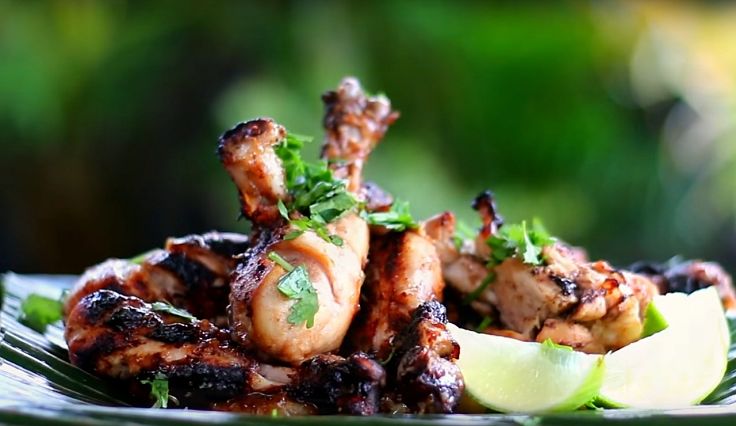
Think beyond Meat and Vegetables
Grilled vegetables and fruit makes delicious side dishes and even desserts. Grilling, especially using an open flame, brings out the best flavor in fruit as their natural sugars are caramelized and they taste sweet and nice. Many favorite fruits are easy to grill once you learn how. Because they are nutrient and fiber rich, they make a healthy side dish or treat.
Tips for Grilling Fruit
Cook in a Basket, on a Pan or on Skewers - The grates on your grill may be unsuitable for fruit which may be prone to falling through and becoming difficult to handle as they soften when cooked. So cook fruit in a basket, on a pan or on skewers
Use Large Pieces - Using large chunks helps to keep the fruit intact when cooked.
Cover Fruit Pieces with a Light Spray of Oil - A little oil helps bring out the flavor and helps prevent the pieces from sticking.
Apply Low, Indirect Heat - Better to grill fruit on the outer edges of the grates or in areas where the heat is indirect.
Allow to Cool Before Serving - Allow the cool to cool prevents burning your mouth.
Fruits Suitable for Grilling
- Peaches
- Plums
- Apples
- Pears
- Figs
- Watermelon
- Cantaloupe
- Pineapple
- Bananas
- Lemons
Roasted Potatoes on the Grill
Prepare the grill for direct cooking over high heat. Pour some rice bran or grape seed oil with some chopped and peeled garlic into a large flameproof roasting pan. Heat the pan on the grill grate, with the cover on, for about 2 minutes.
Carefully add potatoes which have been peeled and quartered to the pan and gently mix to coat all surfaces with the oil. Close the lid on the grill and roast the potatoes until they are golden brown and tender, about 20-25 minutes. Stir the potatoes several times while cooking. Season the potatoes to taste with salt and pepper and a sprinkle of rosemary. Using a slotted spoon, transfer the potatoes to bowl or serving platter and serve hot.
Related Articles
Barbecue Safety Tips - Identifying Hazards and Risks of the BBQ
How to Barbecue - Masterclass, Gourmet BBQ Recipes, Tips, Menu Ideas
Boneless Pork Loin Roast Recipes - Oven, Slow Cooked, Grilled, BBQ
Best Fish Recipes Ever, Grilled, Baked, BBQ, Steamed, Fried
How to Grill Fish on Barbecue, Grilled Fish Recipes and BBQ Tips
Grilled and Barbecued Fruit Recipes | Best Fruit for Grilling
Foil Packet and Oven Bag Meal Recipes Cooked on Grill, Barbecue, Campfire, Oven
Grilled Smoky Eggplant Yogurt Dip Recipe
Barbecued and Grilled Oysters with Spicy Mustard Sauce Recipe
Best Grilled and Barbecued Vegetable Recipes
Best Fish Recipes Ever, Grilled, Baked, BBQ, Steamed, Fried
How to Grill Fish on Barbecue, Grilled Fish Recipes and BBQ Tips
Frozen Salmon Cooking Times - Instructions For Grilling, Baking
Resting Meat After Cooking - Tips and Guides for Grilling, Roasting, Barbecuing